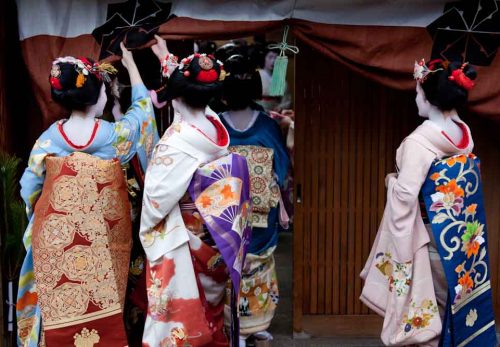Welcome to the Hassaku in flower towns of Kyoto!

Dressed up in a super formal kimono,“Kuromontsuki”. For obi belt a joyous motif such as hexagonal pattern is used.
Have you ever heard of “the Hassaku” before? August’s maiko(geisha)cannot be told without this big event. Hassaku literally means ‘the 1st day of August.’ But this thing…though some of you might know already what it’s all about, for those who just knew it now, I guess it is quite difficult to imagine what it means by just looking word for word.

Geiko,Mameharu san of Gion-Kobu at Hanami-Koji
So let us trace the history…Since the Heian Period(A.D794-around 1185 to 1192), it has been said that there was a custom to give new rice to people whom one receive favors from.
This took place among farmers and trade men in neighborhood to show the heart of celebration. This manners is called ‘Tanomu-No-Sechi’ and it was commonly known by people who lived in the times as custom to deepen a relationship of mutual trust with surrounding people to be shown all the kindness.
Time pass by, the Edo Period comes (A.D1603-1868). As Ieyasu Tokugawa, the first Shogun (a generalissimo for the subjugation of barbarians) entered the Edo Castle, the 1st of August turned out as a day of a ceremony since then. It is said that Daimyo (feudal lord) and Hatamoto(direct retainer of the Shogun) put on Shirokatabira, the white cotton hemp garments and attended the castle to deliver a congratulatory address.

It differs by hanamachi (the flower town) whether to start from 9:30am or 10:00am, but to pay courtesy calls almost complete during the morning.
And today for geiko and maiko living in flower towns of Kyoto, this custom is inherited as the day to pay courtesy calls to teahouses, masters of accomplishments, eating houses and all the others that they always receive favors from. This is a true color of the Hassaku.
August’ s Kanzashi(ornamental hairpins)
Here is maiko(geisha)’s kanzashi for this month. The motif for August is Japanese pampas grass, Susuki. It is common for elder Maiko to wear full-silver one and for the younger, the one colored in silver with pinkish tinge.
On the other hand, geiko (mature geisha) wear cold-colored sapphire such as jade with comb-shaped accessories in white or silver. With Hitoe (unlined Kimono) and Usumono(light silk Kimono), they look superbly perfect for summertime.

This is Kanzashi for elder maiko. It sparkles gracefully like crystal when sunlight falls.
Photos:Copyright(c)2012 Geisha Japan All Rights Reserved
Special Thanks to: WALKKYOTO(some images on this article are provided by http://walkkyoto.exblog.jp/i30/ )











この記事へのコメントはありません。